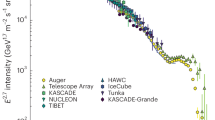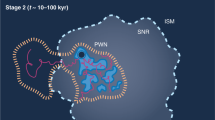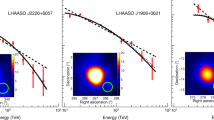Abstract
THE origin and propagation of cosmic rays have been intriguing physicists ever since their discovery in 1912. The main obstacle to identifying the sources of charged particles is the galactic magnetic field. Since the Larmor radii for protons in a typical interstellar field of 3 µgauss are below 30 pc (the typical scale for field irregularities) for E<1017 eV, there should be no direct connection between the arrival directions and the source directions at those energies. Above a few times 1017 eV, however, protons coming from galactic sources should be increasingly anisotropic1. Comparison of the calculated and observed distributions2–4 shows that if the primaries are protons then they should be predominantly extragalactic between a few times 1017 and 1019 eV (ref. 5). More recent data in this energy range6,7 do not change this conclusion. At 1019 eV the Larmor radius of a proton in the Galaxy is about 3 kpc, much larger than the scale height of the magnetic field in most conventional models1,8 and an isotropic distribution above that energy would almost certainly imply a predominantly extragalactic origin if the primaries of the extensive air showers detected are mainly protons. What evidence there is about the mass composition is suggestive of at least some of the very energetic primaries being protons9,10.
This is a preview of subscription content, access via your institution
Access options
Subscribe to this journal
Receive 51 print issues and online access
$199.00 per year
only $3.90 per issue
Buy this article
- Purchase on Springer Link
- Instant access to full article PDF
Prices may be subject to local taxes which are calculated during checkout
Similar content being viewed by others
References
Karakula, S., Osborne, J. L., Roberts, E., and Tkaczyk, W., J. Phys. A., 5, 904–15 (1972).
Lapikens, J., et al., Proc. Int. Conf. Cosmic Rays, 1, 316–20 (University of Tasmania, Hobart, 1971).
Brownlee, R. G., et al., Acta Phys. Hung., 29, Suppl. 3, 383–8 (1970).
Linsley, J., Proc. Int. Conf. Cosmic Rays, 4, 77–99 (TIFR, Bombay, 1963).
Osborne, J. L., Roberts, E., and Wolfendale, A. W., J. Phys. A., 6, 421–33 (1973).
Bell, C. J., et al., Proc. Int. Conf. Cosmic Rays, 4, 2525–8 (University of Denver, 1973).
Brownlee, R. G., et al., Proc. Int. Conf. Cosmic Rays, 4, 2530–3 (University of Denver, 1973).
Parker, E. N., Astrophys. space Sci., 24, 279–88 (1973).
Watson, A. A., and Wilson, J. G., J. Phys. A., 7, 1199–212 (1974).
Lapikens, J., 1975, J. Phys. A: (in the press).
Linsley, J., and Watson, A. A., Nature, 249, 816–7 (1974).
Krasilnikov, D. D., Abstr. of 4th European Symposium on Cosmic Rays, 27 (Institute of Nuclear Research, University of Lodz; 1974).
Krasilnikov, D. D., et al., J. Phys. A., 7, L176–80 (1974).
Hillas, A. M., and Ouldridge, M., Nature, 253, 609–10 (1975).
Kiraly, P., and White, M., J. Phys. A. (in the press).
Author information
Authors and Affiliations
Rights and permissions
About this article
Cite this article
KIRALY, P., OSBORNE, J., WHITE, M. et al. Origin of ultra high energy cosmic rays. Nature 255, 619–620 (1975). https://doi.org/10.1038/255619a0
Received:
Accepted:
Issue Date:
DOI: https://doi.org/10.1038/255619a0
This article is cited by
-
Model of Einstein and Hopf for protons in zero-point field and cosmic-ray spectrum
Il Nuovo Cimento A (1978)
Comments
By submitting a comment you agree to abide by our Terms and Community Guidelines. If you find something abusive or that does not comply with our terms or guidelines please flag it as inappropriate.



